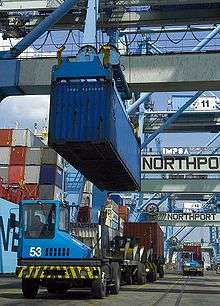Trade barrier
| Part of a series on |
| World trade |
|---|
 |
Trade barriers are government-induced restrictions on international trade.[1] The barriers can take many forms, including the following:
- Tariffs
- Non-tariff barriers to trade
- Import licenses
- Export licenses
- Import quotas
- Subsidies
- Voluntary Export Restraints
- Local content requirements
- Embargo
- Currency devaluation[2]
- Trade restriction
Most trade barriers work on the same principle: the imposition of some sort of cost on trade that raises the price of the traded products. If two or more nations repeatedly use trade barriers against each other, then a trade war results.
Economists generally agree that trade barriers are detrimental and decrease overall economic efficiency; this can be explained by the theory of comparative advantage. In theory, free trade involves the removal of all such barriers, except perhaps those considered necessary for health or national security. In practice, however, even those countries promoting free trade heavily subsidize certain industries, such as agriculture and steel.
Impacts of trade barriers on business
Trade barriers are often criticized for the effect they have on the developing world. Because rich-country players call most of the shots and set trade policies, goods such as crops that developing countries are best at producing still face high barriers. Trade barriers such as taxes on food imports or subsidies for farmers in developed economies lead to overproduction and dumping on world markets, thus lowering prices and hurting poor-country farmers. Tariffs also tend to be anti-poor, with low rates for raw commodities and high rates for labor-intensive processed goods. The Commitment to Development Index measures the effect that rich country trade policies actually have on the developing world.
Trade barriers are mostly a combination of conformity and per-shipment requirements requested abroad, and weak inspection or certification procedures at home. The impact of trade barriers on companies and countries is highly uneven. One particular study showed that small firms are most affected (over 50%).[3]
Another negative aspect of trade barriers is that they result in a limited choice of products and would therefore force customers to pay higher prices and accept inferior quality.[4]
Trade barriers obstruct free trade. Before exporting or importing to other countries, firstly, they must be aware of restrictions that the government imposes on the trade. Subsequently they need to make sure that they are not violating the restrictions by checking related regulations on tax or duty, and finally they probably need a license in order to ensure a smooth export or import business and reduce the risk of penalty or violation. Sometimes the situation becomes even more complicated with the changing of policy and restrictions of a country.
Addressing Trade Barriers
The scarcity of information on trade barriers is a major problem to the competitiveness of developing countries. In the past, many companies relied on spreadsheets and manual processes to keep track of compliance issues related to incoming and outgoing shipments, which risks potential errors and losses of business opportunity. As a result, in 2015 the International Trade Centre launched NTM Business Surveys, a database listing non-tariff barriers from company perspectives to help users identify regulatory and procedural obstacles to trade in 23 developing countries.
Examples of free trade areas
- North American Free Trade Agreement (NAFTA)
- South Asia Free Trade Agreement (SAFTA)
- European Free Trade Association
- European Union (EU)
- Union of South American Nations
- New West Partnership (An internal free-trade zone in Canada between Alberta, British Columbia, and Saskatchewan)
- Gulf Cooperation Council common market
See also
- International free trade agreement
- Free trade
- Customs union
- Agricultural policy
- End-use certificate
- Region lock
Useful Databases on Trade Barriers
- ITC's Market Access Map, an online database of customs tariffs and market requirements
- ITC's Non-Tariff Measures Business Survey database, including regulatory and procedural obstacles that trading companies face both at home and abroad
References
- ↑ "What is trade barrier? definition and meaning". BusinessDictionary.com. Retrieved May 22, 2011.
- ↑ The Wall Street Journal of Europe, October. 11, 2011 page 6
- ↑ The Invisible Barriers to Traded Check
|URL=value (help). Geneva, Switzerland: International Trade Center. 30 June 2015. - ↑ Bleacher Hans; Lee Dahringer; Helmet Leis, International Marketing: A Global Perspective, 1999: page 7
